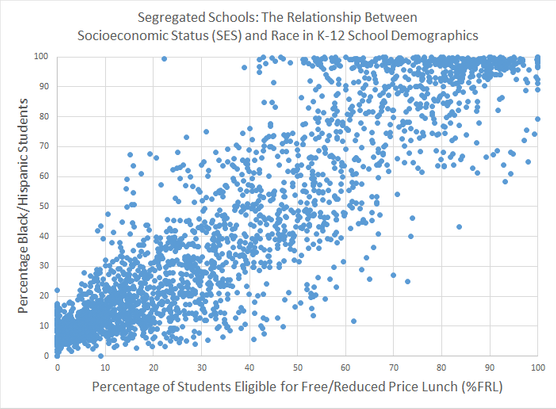SchoolBonusPoints
1. What is SchoolBonusPoints.org?
School segregation is driven in large part by market forces. If K-12 schools serving economically disadvantaged students offered a tangible benefit of their own — “bonus points” toward admission to institutions of higher education — it could attract a more economically and racially diverse group of families. The purpose of this site is to share the idea of these School Bonus Points and to encourage collaboration, seek funding, and stimulate thinking about additional opportunities for reducing K-12 segregation.
2. How segregated are our K-12 schools?
In the graph of school demographics below we can see two clusters containing most of the public schools . The cluster in the lower-left corner are wealthier schools containing mostly White and Asian students, while the cluster in the upper-right corner are economically disadvantaged schools containing mostly Black and Hispanic students.
Data from the NJ DOE 2017-2018 school year performance reports database.
Graph: OUR
SEGREGATED
SCHOOLS
School demographics for 2,517 public K-12 schools in NJ are plotted here with economic disadvantage (percentage of students eligible for FRL)on the x-axis, and race (percentage of Black and Hispanic students) on the y-axis.
The graph illustrates not only the clusters of highly segregated schools that exist at each extreme, but also the perpetuated relationship between race and socioeconomic status across our schools (correlation of .90).
3. How would School Bonus Points reduce school segregation?
If economically disadvantaged K-12 schools offered "bonus points" toward higher education admissions, then increased economic and racial integration of these K-12 schools (and their neighborhoods) would be likely to follow.
In addition, implementing higher education admissions formula “bonus points” on a national scale would:
- reduce impact of school SES on school reputation, and increase use of other indicators to evaluate school quality;
- increase stability of home values as demographics shift across neighborhoods and their associated K-12 schools;
- increase external financial resources accessible to lower-SES schools (e.g., PTA funds);
- increase the likelihood of college acceptance to students from schools with higher proportions of economically disadvantaged students;
- foster diversity at institutions of higher education by race and class.
4. How was the idea of School Bonus Points developed?
The spark for this project was a recorded town hall meeting included in a National Public Radio podcast (Hannah-Jones, 2015). During this meeting, parents of a mostly White middle-income school district objected to receiving students, many of whom were Black and low-income, from shuttered schools in another district.
One parent relayed how this action resulted in a prospective homebuyer ending negotiations on a local property, alluding to market forces that link “property values” to the race and socioeconomic status (SES) of students attending the local school. This occurs as peer characteristics, more than school quality, inform school preferences. Thus peer characteristics also influence neighborhood housing demand (e.g., Abdulkadiroglu, Pathak, Schellenberg & Walters, 2017; Renzulli & Evans, 2005; Rothstein, 2006).
This illustrates how market forces influence home values based on the student demographics of the zoned schools. It is clear that something counter to these current market forces is needed. This gave rise to the concept of School Bonus Points.
